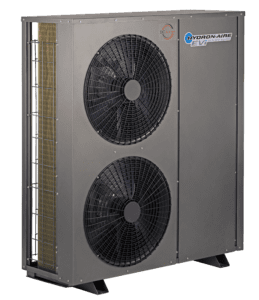Heat pumps in Manitoba, particularly cold climate air source heat pumps, are highly energy-efficient and can help reduce your carbon footprint when replacing a fossil fuel heating system. These heat pumps transfer heat from the outside air to warm your home effectively.
Cold climate air source heat pumps are more efficient and can function effectively in lower temperatures compared to conventional air source heat pumps. Traditional heat pumps often lose a substantial amount of heating capacity in colder conditions and are usually not recommended for use when temperatures fall below −10°C. In contrast, cold climate heat pumps in Manitoba can still provide heating at temperatures as low as −25°C or −30°C, depending on the manufacturer’s specifications.
Check out Hydron-Aire EVI System products like Hydron-Aire EVI Air to Water Heat Pump, Hydron-Aire Thermal Energy Storage Tank, and Hydron-Aire Indirect Hot Water Tank.
Manitoba Hydro breaks down the 2 main types of cold climate air source heat pumps in Manitoba and their benefits, plus some maintenance tips.
Centrally Ducted Heat Pumps
A centrally ducted heat pump resembles a central air conditioner, featuring an outdoor unit and a coil integrated into the home’s ductwork.
In summer, the heat pump functions like a central air conditioner. The circulating fan draws air over the indoor coil, where the refrigerant absorbs heat from the indoor air. This heated refrigerant is then pumped to the outdoor unit (condenser), which expels the heat into the outside air, cooling the interior of the home.
In winter, the heat pump reverses the flow of refrigerant. The outdoor unit extracts heat from the outside air and transfers it to the indoor coil within the ductwork. As air passes over this coil, it absorbs the heat and is distributed throughout the home.
Mini-Split (Ductless) Heat Pumps
A mini-split heat pump functions similarly to a centrally ducted heat pump but does not rely on ductwork. Most mini-split systems consist of an outdoor unit and one or more indoor units (heads). Each indoor unit features a built-in fan that circulates air over the coil to absorb or release heat.
To effectively heat and cool an entire home, a system with multiple indoor units is typically necessary. Mini-split heat pump systems are particularly well-suited for homes without ductwork, such as those with hot water boilers, steam boilers, or electric baseboard heaters. They are also ideal for open-concept floor plans, as these layouts require fewer indoor units to maintain comfort.
Hydron-Aire EVI Heat Pumps in Manitoba
Hydron-Aire EVI heat pumps in Manitoba can be utilized with existing ductwork or may not require ducts at all. Instead, they can supply water to your radiant floor system or operate with a standalone air handler.

Maintenance Recommendations for Heat Pumps in Manitoba
We recommend the following maintenance tasks:
- Inspect the air filter every three months to determine if it needs replacement.
- Regularly check that supply and return air vents are clear.
- Routinely inspect and clean the outdoor coil to remove leaves, seeds, dust, and lint.
- Schedule an annual system check with a qualified service professional.
A licensed refrigeration mechanic can provide you with additional details on the operation and maintenance of your system.
Operating Temperatures
Air source heat pumps in Manitoba have a minimum outdoor operating temperature, and their heating capacity decreases as the outside air temperature drops. In extremely cold weather, they typically require an auxiliary heating source to maintain indoor temperatures. For cold climate units, this auxiliary heat source is usually electric coils, though some systems can work with gas furnaces or boilers.
Most air source systems have three key temperature thresholds that can be set by your contractor during installation:
- Thermal Balance Point: At this temperature, the heat pump cannot provide sufficient heat for the home on its own.
- Economic Balance Point: This is the temperature at which one fuel becomes more economical than the other. In colder conditions, it may be more cost-effective to use supplemental fuel (like natural gas) instead of electricity.
- Low Temperature Cut-Off: This is the minimum operating temperature at which the heat pump can function safely, or where its efficiency is equal to or less than that of the electric auxiliary heating system.
Controls
We recommend using a thermostat that controls both the air source heat pump and the auxiliary heating system. Having a single control helps prevent competition between the heat pump and the auxiliary system. If separate controls are used, the auxiliary heating system could potentially operate while the heat pump is in cooling mode.
Benefits of Heat Pumps in Manitoba
Energy Efficiency
Cold climate air source heat pumps in Manitoba are more efficient compared to other systems like electric furnaces, boilers, and baseboard heaters.
Environmentally Friendly
Air source heat pumps extract heat from outdoor air and combine it with heat generated by the electrically-driven compressor to warm your home. This process reduces energy consumption, greenhouse gas emissions, and the overall environmental impact.
Versatility
Air source heat pumps provide both heating and cooling as needed. Homes equipped with a cold climate air source heat pump do not require a separate air conditioning system.
Discover the Canada Greener Homes Grant
A new or replacement cold climate air source heat pump system might be eligible for the Greener Homes Grant offered by Natural Resources Canada. But the Canada Greener Homes Grant is no longer open for new applications.

